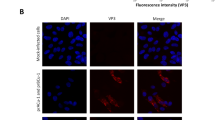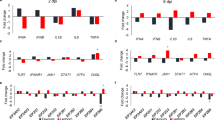Abstract
Using a replication-deficient retroviral vector based on the avian leukosis virus (ALV), we inserted into the chicken genome a transgene encoding a secreted protein, β-lactamase, under the control of the ubiquitous cytomegalovirus (CMV) promoter. Biologically active β-lactamase was secreted into the serum and egg white of four generations of transgenic chickens. The expression levels were similar in successive generations, and expression levels in the magnum of the oviduct were constant over at least 16 months in transgenic hens, indicating that the transgene was stable and not subject to silencing. These results support the potential of the hen as a bioreactor for the production of commercially valuable, biologically active proteins in egg white.
This is a preview of subscription content, access via your institution
Access options
Subscribe to this journal
Receive 12 print issues and online access
$209.00 per year
only $17.42 per issue
Buy this article
- Purchase on SpringerLink
- Instant access to full article PDF
Prices may be subject to local taxes which are calculated during checkout



Similar content being viewed by others
References
Clark, A.J. et al. The molecular manipulation of milk composition. Genome 31, 950–955 (1989).
Devinoy, E. et al. High level production of human growth hormone in the milk of transgenic mice: the upstream region of the rabbit whey acidic protein (WAP) gene targets transgene expression to the mammary gland. Transgenic Res. 3, 79–89 (1994).
Ebert, K.M. et al. Transgenic production of a variant of human tissue-type plasminogen activator in goat milk: generation of transgenic goats and analysis of expression. Biotechnology (NY) 9, 835–838 (1991).
Velander, W.H. et al. High-level expression of a heterologous protein in the milk of transgenic swine using the cDNA encoding human protein C. Proc. Natl. Acad. Sci. USA 89, 12003–12007 (1992).
Raju, T.S., Briggs, J.B., Borge, S.M. & Jones, A.J. Species-specific variation in glycosylation of IgG: evidence for the species-specific sialylation and branch-specific galactosylation and importance for engineering recombinant glycoprotein therapeutics. Glycobiology 10, 477–486 (2000).
Love, J., Gribbin, C., Mather, C. & Sang, H. Transgenic birds by DNA microinjection. Biotechnology (NY) 12, 60–63 (1994).
Carsience, R.S., Clark, M.E., Verrinder Gibbins, A.M. & Etches, R.J. Germline chimeric chickens from dispersed donor blastodermal cells and compromised recipient embryos. Development 117, 669–675 (1993).
Salter, D.W. et al. Gene insertion into the chicken germ line by retroviruses. Poult. Sci. 65, 1445–1458 (1986).
Bosselman, R.A. et al. Replication-defective vectors of reticuloendotheliosis virus transduce exogenous genes into somatic stem cells of the unincubated chicken embryo. J. Virol. 63, 2680–2689 (1989).
Thoraval, P. et al. Germline transmission of exogenous genes in chickens using helper-free ecotropic avian leukosis virus–based vectors. Transgenic Res. 4, 369–377 (1995).
Harvey, A.J., Speksnijder, G., Baugh, L.R., Morris, J.A. & Ivarie, R. Consistent production of transgenic chickens using replication deficient retroviral vectors and high-throughput screening procedures. Poult. Sci. 81, 202–212 (2002).
Petropoulos, C.J., Payne, W., Salter, D.W. & Hughes, S.H. Using avian retroviral vectors for gene transfer. J. Virol. 66, 3391–3397 (1992).
Moore, J.T., Davis, S.T. & Dev, I.K. The development of β-lactamase as a highly versatile genetic reporter for eukaryotic cells. Anal. Biochem. 247, 203–209 (1997).
Cosset, F.L. et al. Improvement of avian leukosis virus (ALV)–based retrovirus vectors by using different cis-acting sequences from ALVs. J. Virol. 65, 3388–3394 (1991).
Cosset, F.L. et al. A new avian leukosis virus–based packaging cell line that uses two separate transcomplementing helper genomes. J. Virol. 64, 1070–1078 (1990).
Cosset, F.L. et al. Packaging cells for avian leukosis virus–based vectors with various host ranges. J. Virol. 66, 5671–5676 (1992).
Fadly, A.M. & Smith, E.J. Isolation and some characteristics of a subgroup J–like avian leukosis virus associated with myeloid leukosis in meat-type chickens in the United States. Avian Dis. 43, 391–400 (1999).
Schaefer-Klein, J. et al. The EV-O-derived cell line DF-1 supports the efficient replication of avian leukosis-sarcoma viruses and vectors. Virology 248, 305–311 (1998).
Acknowledgements
We thank Robert Harvey for the β-lactamase plasmid and Henry Marks and the University of Georgia Poultry Science Department for access to poultry facilities. We thank Wei Hu, Lyn Olliff, Michael Morgan, Jeff Rapp, Sara Mathews, Heath Sellers, and Tom Beacorn for technical assistance. This work was supported in part by research grants to R.I. from the Georgia Research Alliance, the Applied Technology Development Corp., and AviGenics, Inc.
Author information
Authors and Affiliations
Corresponding author
Rights and permissions
About this article
Cite this article
Harvey, A., Speksnijder, G., Baugh, L. et al. Expression of exogenous protein in the egg white of transgenic chickens. Nat Biotechnol 20, 396–399 (2002). https://doi.org/10.1038/nbt0402-396
Received:
Accepted:
Issue Date:
DOI: https://doi.org/10.1038/nbt0402-396
This article is cited by
-
Study of the regulatory elements of the Ovalbumin gene promoter using CRISPR technology in chicken cells
Journal of Biological Engineering (2023)
-
Engineering of Plants for Efficient Production of Therapeutics
Molecular Biotechnology (2021)
-
Avian Bioreactor Systems: A Review
Molecular Biotechnology (2018)
-
Expression of recombinant human lysozyme in transgenic chicken promotes the growth of Bifidobacterium in the intestine and improves postnatal growth of chicken
AMB Express (2016)
-
The transgenic animal platform for biopharmaceutical production
Transgenic Research (2016)



